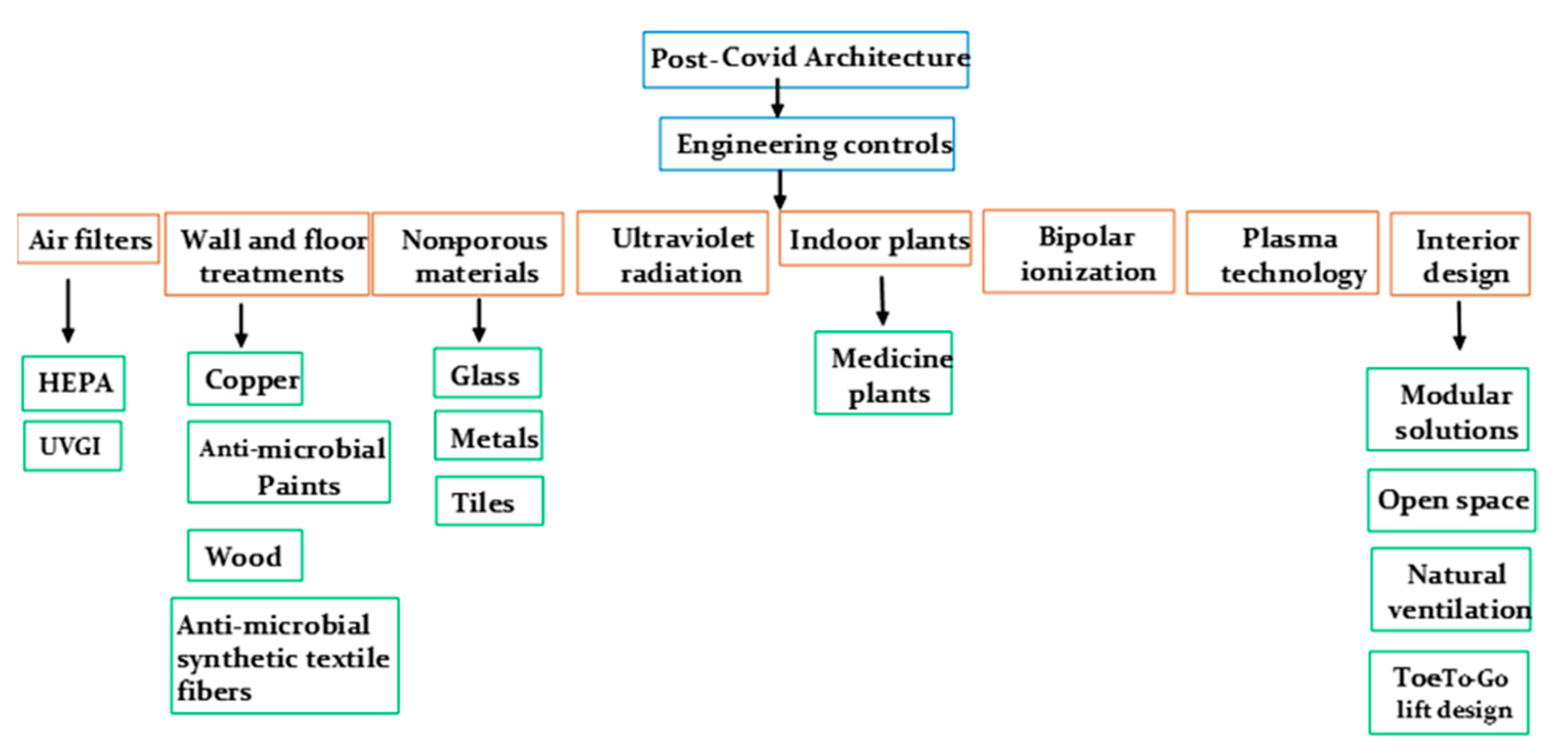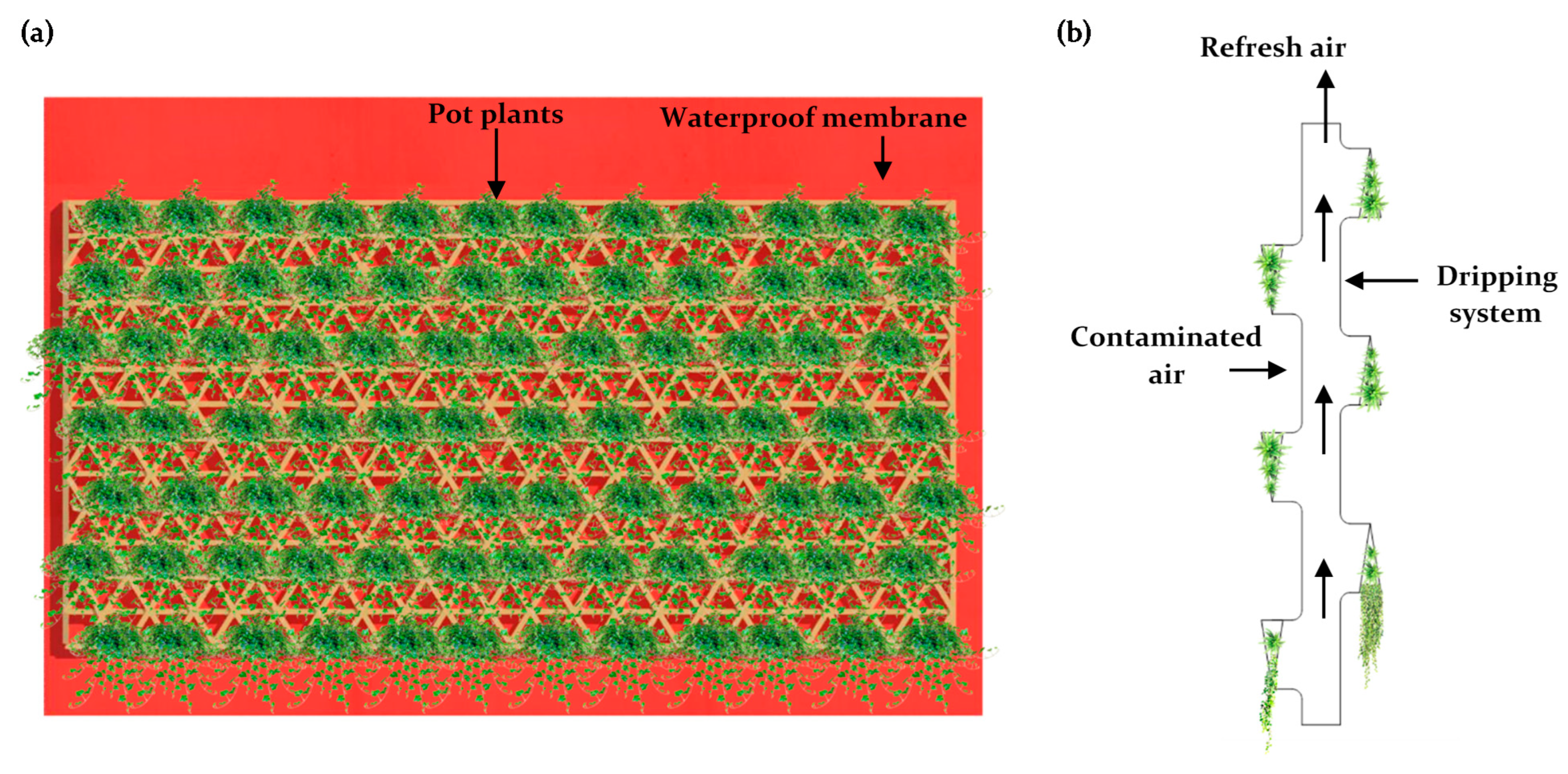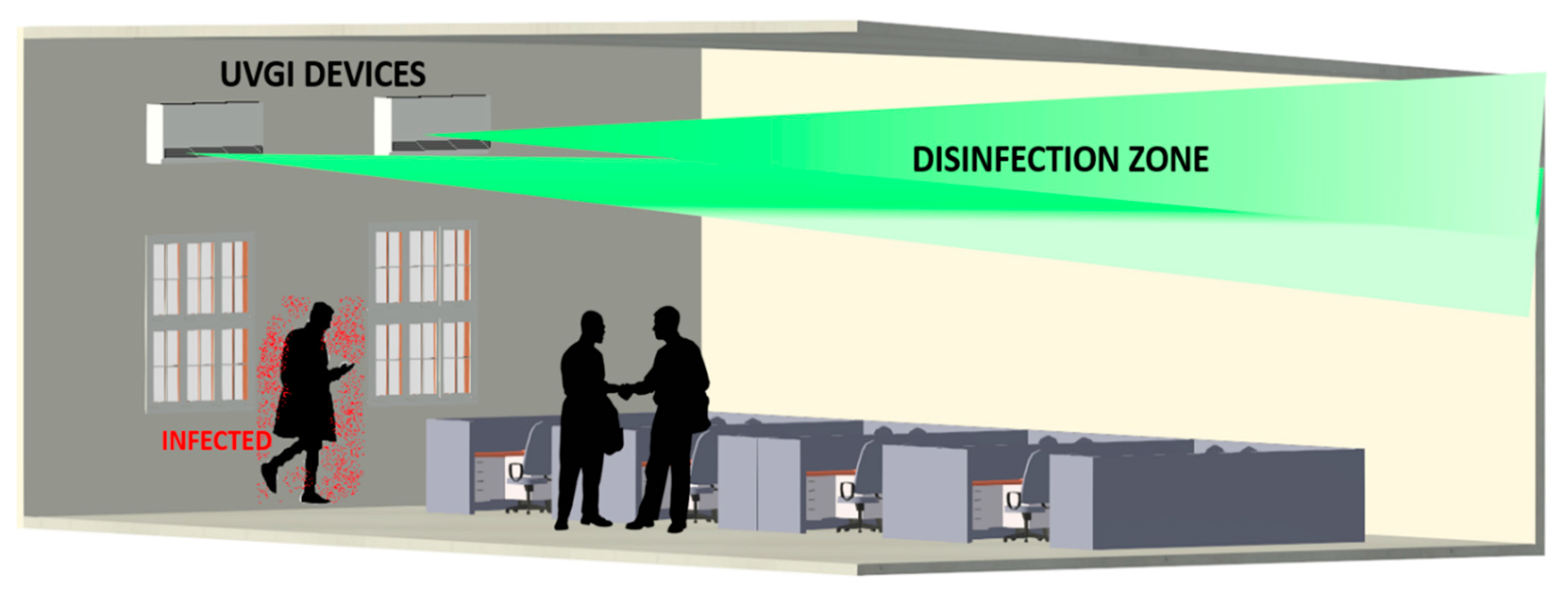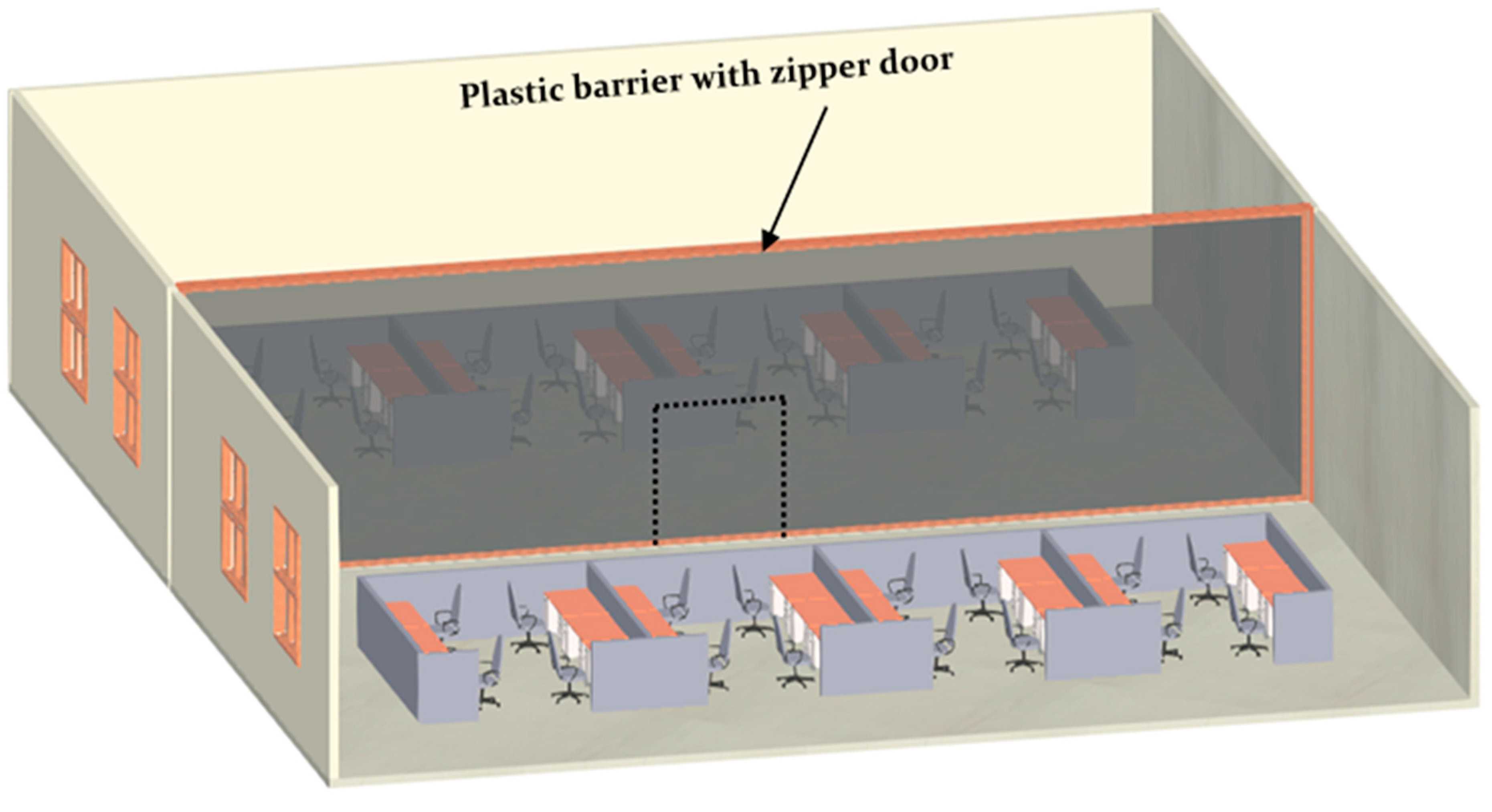Designing Post COVID-19 Buildings: Approaches for Achieving Healthy Buildings
Abstract
:1. Introduction
2. Method/Bibliometric Analysis
3. Existing Healthy Building Technologies
4. Overview of Engineering Controls to Reduce the Transmission of COVID-19
4.1. Materials That Offer Antimicrobial Protection for Walls and Floor
4.2. Ultraviolet Radiation
4.3. Air Cleaning Plants
4.4. Bipolar Ionization
4.5. Disinfectant Fogging Systems
4.6. Other Technologies
5. Recommended Solutions for the Post COVID-19 Buildings
5.1. Existing Buildings
5.2. Future Buildings
6. Conclusions
- Installation of HVAC systems (in existing and future buildings) with UVGI and Bipolar ionization, which improve the indoor air quality and reduce the transmission of communicable diseases.
- Increased contactless routes, such as smartphone control lifts, touchless door and window locks, and automatic opening doors with face ID.
- Application of antimicrobial paint and particles to existing and future buildings, which disinfect pathogens in a short period to reduce disease transmission.
- Utilization of antimicrobial copper alloy-coated touch surfaces (e.g., door and window handles, wall, etc.).
- Modification of the geometry of roofs, introducing more open space and separating open spaces of building designs with UV filter glass.
Author Contributions
Funding
Institutional Review Board Statement
Informed Consent Statement
Data Availability Statement
Acknowledgments
Conflicts of Interest
Abbreviations
| ASHRAE | American Society of Heating, Refrigerating and Air-Conditioning Engineers |
| CAR | Chinese Association of Refrigeration |
| DNA | Deoxyribonucleic Acid |
| EPA | Environmental Protection Agency |
| GBM | Green building material |
| GUV | germicidal ultraviolet |
| HEPA | High-efficiency particulate air |
| HO | Hydroxyl |
| HVAC | Heating, ventilation, and air conditioning |
| IEQ | Indoor environmental quality |
| MERV | Minimum efficiency reporting value |
| NBPI | Needlepoint bipolar ionization |
| PCO | Photocatalytic oxidation |
| REHVA | Federation of European Heating and Air-conditioning Associations |
| RNA | Ribonucleic acid |
| SHASE | Society of Heating, Air-Conditioning and Sanitary Engineers |
| UV | Ultraviolet |
| UVGI | Ultraviolet germicidal irradiation |
| VOC | Volatile organic compounds |
| WoS | Web of Science |
References
- Selvaranjan, K.; Navaratnam, S.; Rajeev, P.; Ravintherakumaran, N. Environmental challenges induced by extensive use of face masks during COVID-19: A review and potential solutions. Environ. Chall. 2021, 3, 100039. [Google Scholar] [CrossRef]
- El-Sayed, M.M.H.; Elshorbany, Y.F.; Koehler, K. On the impact of the COVID-19 pandemic on air quality in Florida. Environ. Pollut. 2021, 285, 117451. [Google Scholar] [CrossRef] [PubMed]
- Awada, M.; Becerik-Gerber, B.; Hoque, S.; O′Neill, Z.; Pedrielli, G.; Wen, J.; Wu, T. Ten questions concerning occupant health in buildings during normal operations and extreme events including the COVID-19 pandemic. Build. Environ. 2021, 188, 107480. [Google Scholar] [CrossRef]
- Fennelly, K.P. Particle sizes of infectious aerosols: Implications for infection control. Lancet Respir. Med. 2020, 8, 914–924. [Google Scholar] [CrossRef]
- Albuquerque, P.C.; Gomes, J.F.; Bordado, J.C. Assessment of exposure to airborne ultrafine particles in the urban environment of Lisbon, Portugal. J. Air Waste Manag. Assoc. 2012, 62, 373–380. [Google Scholar] [CrossRef] [Green Version]
- Mandavilli, A. How Long Will Coronavirus Live on Surfaces or in the Air around you? New York Times, 17 March 2020; p. 10. Available online: https://www.ncbi.nlm.nih.gov/search/research-news/8941/(accessed on 17 March 2020).
- Megahed, N.A.; Ghoneim, E.M. Indoor air quality: Rethinking rules of building design strategies in post-pandemic architecture. Environ. Res. 2021, 193, 110471. [Google Scholar] [CrossRef] [PubMed]
- Tokazhanov, G.; Tleuken, A.; Guney, M.; Turkyilmaz, A.; Karaca, F. How is COVID-19 experience transforming sustainability requirements of residential buildings? A review. Sustainability 2020, 12, 8732. [Google Scholar] [CrossRef]
- Kaklauskas, A.; Lepkova, N.; Raslanas, S.; Vetloviene, I.; Milevicius, V.; Sepliakov, J. COVID-19 and green housing: A Review of relevant literature. Energies 2021, 14, 2072. [Google Scholar] [CrossRef]
- Šujanová, P.; Rychtáriková, M.; Sotto Mayor, T.; Hyder, A. A healthy, energy-efficient and comfortable indoor environment, a review. Energies 2019, 12, 1414. [Google Scholar] [CrossRef] [Green Version]
- Al horr, Y.; Arif, M.; Katafygiotou, M.; Mazroei, A.; Kaushik, A.; Elsarrag, E. Impact of indoor environmental quality on occupant well-being and comfort: A review of the literature. Int. J. Sustain. Built Environ. 2016, 5, 1–11. [Google Scholar] [CrossRef]
- Lai, A.C.K.; Mui, K.W.; Wong, L.T.; Law, L.Y. An evaluation model for indoor environmental quality (IEQ) acceptance in residential buildings. Energy Build. 2009, 41, 930–936. [Google Scholar] [CrossRef]
- Lewtas, J. Air pollution combustion emissions: Characterization of causative agents and mechanisms associated with cancer, reproductive, and cardiovascular effects. Mutat. Res. Rev. Mutat. Res. 2007, 636, 95–133. [Google Scholar] [CrossRef] [PubMed]
- Jantunen, M.; Hänninen, O.; Katsouyanni, K.; Knöppel, H.; Künzli, N.; Lebret, E.; Maroni, M.; Saarela, K.; Sram, R.; Zmirou, D. Air pollution exposure in European cities: The ‘EXPOLIS’ study. J. Expo. Anal. Environ. Epidemiol. 1998, 8, 495–518. [Google Scholar]
- Morano, P.; Guarnaccia, C.; Tajani, F.; Di Liddo, F.; Anelli, D. An analysis of the noise pollution influence on the housing prices in the central area of the city of Bari. J. Phys. Conf. Ser. 2020, 1603, 012027. [Google Scholar] [CrossRef]
- Magrini, A.; Lisot, A. Noise Reduction Interventions in the Urban Environment as a form of Control of Indoor Noise Levels. Energy Procedia 2015, 78, 1653–1658. [Google Scholar] [CrossRef] [Green Version]
- Chen, Y.; Lei, J.; Li, J.; Zhang, Z.; Yu, Z.; Du, C. Design characteristics on the indoor and outdoor air environments of the COVID-19 emergency hospital. J. Build. Eng. 2022, 45, 103246. [Google Scholar] [CrossRef]
- Larsen, T.S.; Rohde, L.; Jønsson, K.T.; Rasmussen, B.; Jensen, R.L.; Knudsen, H.N.; Witterseh, T.; Bekö, G. IEQ-Compass—A tool for holistic evaluation of potential indoor environmental quality. Build. Environ. 2020, 172, 106707. [Google Scholar] [CrossRef]
- Kubba, S. Chapter Seven-Indoor Environmental Quality. In Handbook of Green Building Design and Construction; Kubba, S., Ed.; Butterworth-Heinemann: Boston, UK, 2012; pp. 313–360. [Google Scholar] [CrossRef]
- Pan, Y.; Du, C.; Fu, Z.; Fu, M. Re-thinking of engineering operation solutions to HVAC systems under the emerging COVID-19 pandemic. J. Build. Eng. 2021, 43, 102889. [Google Scholar] [CrossRef]
- Kapoor, N.R.; Kumar, A.; Meena, C.S.; Kumar, A.; Alam, T.; Balam, N.B.; Ghosh, A. A systematic review on indoor environmental quality in naturally ventilated school classrooms: A way forward. Adv. Civ. Eng. 2021, 2021, 8851685. [Google Scholar] [CrossRef]
- Śmiełowska, M.; Marć, M.; Zabiegała, B. Indoor air quality in public utility environments—A review. Environ. Sci. Pollut. Res. 2017, 24, 11166–11176. [Google Scholar] [CrossRef] [Green Version]
- Tran, V.V.; Park, D.; Lee, Y.-C. Indoor air pollution, related human diseases, and recent trends in the control and improvement of indoor air quality. Int. J. Environ. Res. Public Health 2020, 17, 2927. [Google Scholar] [CrossRef] [PubMed] [Green Version]
- Schulze, F.; Gao, X.; Virzonis, D.; Damiati, S.; Schneider, M.R.; Kodzius, R. Air quality effects on human health and approaches for its assessment through microfluidic chips. Genes 2017, 8, 244. [Google Scholar] [CrossRef] [PubMed]
- Shen, J.; Kong, M.; Dong, B.; Birnkrant, M.J.; Zhang, J. A systematic approach to estimating the effectiveness of multi-scale IAQ strategies for reducing the risk of airborne infection of SARS-CoV-2. Build. Environ. 2021, 200, 107926. [Google Scholar] [CrossRef]
- Shrubsole, C.; Dimitroulopoulou, S.; Foxall, K.; Gadeberg, B.; Doutsi, A. IAQ guidelines for selected volatile organic compounds (VOCs) in the UK. Build. Environ. 2019, 165, 106382. [Google Scholar] [CrossRef]
- Sass, V.; Kravitz-Wirtz, N.; Karceski, S.M.; Hajat, A.; Crowder, K.; Takeuchi, D. The effects of air pollution on individual psychological distress. Health Place 2017, 48, 72–79. [Google Scholar] [CrossRef]
- Akadiri, P.O.; Chinyio, E.A.; Olomolaiye, P.O. Design of a sustainable building: A conceptual framework for implementing sustainability in the building sector. Buildings 2012, 2, 126–152. [Google Scholar] [CrossRef] [Green Version]
- Wineman, J.; Hwang, Y.; Kabo, F.; Owen-Smith, J.; Davis, G.F. Spatial layout, social structure, and innovation in organizations. Environ. Plan. B Plan. Des. 2014, 41, 1100–1112. [Google Scholar] [CrossRef]
- Chatzikonstantinou, I.; Bengisu, E. Interior spatial layout with soft objectives using evolutionary computation. In Proceedings of the 2016 IEEE Congress on Evolutionary Computation (CEC), Vancouver, BC, Canada, 24–29 July 2016; pp. 2306–2312. [Google Scholar]
- Wolfs, E. Biophilic design and Bio-collaboration: Applications and implications in the field of Industrial Design. Arch. Des. Res. 2015, 28, 71–89. [Google Scholar]
- Det Udomsap, A.; Hallinger, P. A bibliometric review of research on sustainable construction, 1994–2018. J. Clean. Prod. 2020, 254, 120073. [Google Scholar] [CrossRef]
- de San José, C.A. How Technology Can Help Create Healthy Buildings. Retrieved 2020, 8, 2020. Available online: https://www.workdesign.com/2020/07/how-technology-can-help-create-healthy-buildings/ (accessed on 5 June 2021).
- Agarwal, N.; Meena, C.S.; Raj, B.P.; Saini, L.; Kumar, A.; Gopalakrishnan, N.; Kumar, A.; Balam, N.B.; Alam, T.; Kapoor, N.R.; et al. Indoor air quality improvement in COVID-19 pandemic: Review. Sustain. Cities Soc. 2021, 70, 102942. [Google Scholar] [CrossRef] [PubMed]
- Megahed, N.A.; Ghoneim, E.M. Antivirus-built environment: Lessons learned from COVID-19 pandemic. Sustain. Cities Soc. 2020, 61, 102350. [Google Scholar] [CrossRef]
- Zhang, N.; Wang, P.; Miao, T.; Chan, P.-T.; Jia, W.; Zhao, P.; Su, B.; Chen, X.; Li, Y. Real human surface touch behavior based quantitative analysis on infection spread via fomite route in an office. Build. Environ. 2021, 191, 107578. [Google Scholar] [CrossRef]
- Dorfman, P. This Chicago Office Tower Claims to Be the First Post-COVID Building. Available online: https://blog.bluebeam.com/post-covid-office-building-fulton-east/ (accessed on 8 August 2021).
- Brenner, J. New Chicago Office Building Is One of the First in the U.S. Designed for Post COVID-19 Environment. Available online: https://www.forbes.com/sites/juliabrenner/2020/06/15/new-chicago-office-building-is-one-of-the-first-in-the-us-designed-for--post-covid-19-environment/?sh=71b7b55363a4 (accessed on 10 August 2021).
- Hadid, Z.; Schumacher, P. Bee’ah Headquarters. Herskhazeen Sharjah. Available online: http://www.herskhazeen.com/beeah-headquarters/ (accessed on 9 June 2021).
- Kretchmer, H. COVID-19: Is This What the Office of the Future Will Look Like? In World Economic Forum. Available online: https://www.weforum.org/agenda/2020/04/covid19-coronavirus-change-office-workhomeworking-remote-design/ (accessed on 15 July 2020).
- Lipinski, T.; Ahmad, D.; Serey, N.; Jouhara, H. Review of ventilation strategies to reduce the risk of disease transmission in high occupancy buildings. Int. J. Thermofluids 2020, 7–8, 100045. [Google Scholar] [CrossRef]
- Li, C.; Tang, H. Study on ventilation rates and assessment of infection risks of COVID-19 in an outpatient building. J. Build. Eng. 2021, 42, 103090. [Google Scholar] [CrossRef]
- Elsaid, A.M.; Ahmed, M.S. Indoor air quality strategies for air-conditioning and ventilation systems with the spread of the global Coronavirus (COVID-19) epidemic: Improvements and recommendations. Environ. Res. 2021, 199, 111314. [Google Scholar] [CrossRef] [PubMed]
- Guo, M.; Xu, P.; Xiao, T.; He, R.; Dai, M.; Miller, S.L. Review and comparison of HVAC operation guidelines in different countries during the COVID-19 pandemic. Build. Environ. 2021, 187, 107368. [Google Scholar] [CrossRef]
- Balocco, C.; Leoncini, L. Energy cost for effective ventilation and air quality for healthy buildings: Plant proposals for a historic building school reopening in the Covid-19 era. Sustainability 2020, 12, 8737. [Google Scholar] [CrossRef]
- Rashid, F.A. Dubai Demand Side Management Strategy 2030: What’s Ahead? Available online: https://www.dubaichamber.com/wp-content/uploads/2020/02/How-has-COVID-19-Re-shaped-Commercial-Green-Buildings.pdf (accessed on 6 June 2021).
- Buivydiene, D.; Krugly, E.; Ciuzas, D.; Tichonovas, M.; Kliucininkas, L.; Martuzevicius, D. Formation and characterisation of air filter material printed by melt electrospinning. J. Aerosol Sci. 2019, 131, 48–63. [Google Scholar] [CrossRef]
- Nor, N.S.M.; Yip, C.W.; Ibrahim, N.; Jaafar, M.H.; Rashid, Z.Z.; Mustafa, N.; Hamid, H.H.A.; Chandru, K.; Latif, M.T.; Saw, P.E.; et al. Particulate matter (PM2.5) as a potential SARS-CoV-2 carrier. Sci. Rep. 2021, 11, 2508. [Google Scholar] [CrossRef] [PubMed]
- Ginestet, A.; Pugnet, D.; Rowley, J.; Bull, K.; Yeomans, H. Development of a new photocatalytic oxidation air filter for aircraft cabin. Indoor Air 2005, 15, 326–334. [Google Scholar] [CrossRef] [PubMed]
- ElBagoury, M.; Tolba, M.M.; Nasser, H.A.; Jabbar, A.; Elagouz, A.M.; Aktham, Y.; Hutchinson, A. The find of COVID-19 vaccine: Challenges and opportunities. J. Infect. Public Health 2021, 14, 389–416. [Google Scholar] [CrossRef]
- Zheng, W.; Hu, J.; Wang, Z.; Li, J.; Fu, Z.; Li, H.; Jurasz, J.; Chou, S.K.; Yan, J. COVID-19 impact on operation and energy consumption of Heating, Ventilation and Air-Conditioning (HVAC) systems. Adv. Appl. Energy 2021, 3, 100040. [Google Scholar] [CrossRef]
- Batéjat, C.; Grassin, Q.; Manuguerra, J.-C.; Leclercq, I. Heat inactivation of the severe acute respiratory syndrome coronavirus 2. J. Biosaf. Biosecurity 2021, 3, 1–3. [Google Scholar] [CrossRef] [PubMed]
- Sodiq, A.; Khan, M.A.; Naas, M.; Amhamed, A. Addressing COVID-19 contagion through the HVAC systems by reviewing indoor airborne nature of infectious microbes: Will an innovative air recirculation concept provide a practical solution? Environ. Res. 2021, 199, 111329. [Google Scholar] [CrossRef]
- Franco, A.; Miserocchi, L.; Testi, D. A method for optimal operation of HVAC with heat pumps for reducing the energy demand of large-scale non residential buildings. J. Build. Eng. 2021, 43, 103175. [Google Scholar] [CrossRef]
- Cortes, A.A.; Zuñiga, J.M. The use of copper to help prevent transmission of SARS-coronavirus and influenza viruses. A general review. Diagn. Microbiol. Infect. Dis. 2020, 98, 115176. [Google Scholar] [CrossRef] [PubMed]
- Marzoli, F.; Bortolami, A.; Pezzuto, A.; Mazzetto, E.; Piro, R.; Terregino, C.; Bonfante, F.; Belluco, S. A systematic review of human coronaviruses survival on environmental surfaces. Sci. Total Environ. 2021, 778, 146191. [Google Scholar] [CrossRef] [PubMed]
- Otter, J.; Brophy, K.; Palmer, J.; Harrison, N.; Riley, J.; Williams, D.; Larrouy-Maumus, G. Smart Surfaces to Tackle Infection and Antimicrobial Resistance; Institute for Molecular Science and Engineering; Imperial College London: London, UK, 2020. [Google Scholar]
- Shirvanimoghaddam, K.; Akbari, M.K.; Yadav, R.; Al-Tamimi, A.K.; Naebe, M. Fight against COVID-19: The case of antiviral surfaces. APL Mater. 2021, 9, 031112. [Google Scholar] [CrossRef]
- Goss, G. How Hygienic Is the World after Covid. Goss. Available online: https://gosscoatings.co.uk/how-hygienic-is-the-world-after-covid/2021 (accessed on 9 September 2021).
- Rush, J. Inside Antimicrobial Coatings. Products Finishing. Available online: https://www.pfonline.com/articles/inside-antimicrobial-coatings (accessed on 9 September 2021).
- Daeneke, T.; Dahr, N.; Atkin, P.; Clark, R.M.; Harrison, C.J.; Brkljača, R.; Pillai, N.; Zhang, B.Y.; Zavabeti, A.; Ippolito, S.J.; et al. Surface water dependent properties of sulfur-rich molybdenum sulfides: Electrolyteless gas phase water splitting. ACS Nano 2017, 11, 6782–6794. [Google Scholar] [CrossRef] [PubMed]
- Munir, M.T.; Pailhoriès, H.; Aviat, F.; Lepelletier, D.; Pape, P.L.; Dubreil, L.; Irle, M.; Buchner, J.; Eveillard, M.; Federighi, M.; et al. Hygienic Perspectives of Wood in Healthcare Buildings. Hygiene 2021, 1, 12–33. [Google Scholar] [CrossRef]
- Seladi-Schulman, J. Can UV Light Kill the New Coronavirus? Available online: https://www.healthline.com/health/does-uv-kill-coronavirus#uvc-light-and-coronavirus (accessed on 9 September 2021).
- Vranay, F.; Pirsel, L.; Kacik, R.; Vranayova, Z. Adaptation of HVAC systems to reduce the spread of COVID-19 in buildings. Sustainability 2020, 12, 9992. [Google Scholar] [CrossRef]
- Kumar, A.; Sagdeo, A.; Sagdeo, P.R. Possibility of using ultraviolet radiation for disinfecting the novel COVID-19. Photodiagnosis Photodyn. Ther. 2021, 34, 102234. [Google Scholar] [CrossRef]
- Wang, C.; Lu, S.; Zhang, Z. Inactivation of airborne bacteria using different UV sources: Performance modeling, energy utilization, and endotoxin degradation. Sci. Total Environ. 2019, 655, 787–795. [Google Scholar] [CrossRef]
- Nardell, E.A.; Bucher, S.J.; Brickner, P.W.; Wang, C.; Vincent, R.L.; Becan-McBride, K.; James, M.A.; Michael, M.; Wright, J.D. Safety of upper-room ultraviolet germicidal air disinfection for room occupants: Results from the tuberculosis ultraviolet shelter study. Public Health Rep. 2008, 123, 52–60. [Google Scholar] [CrossRef] [PubMed] [Green Version]
- Storm, N.; McKay, L.G.A.; Downs, S.N.; Johnson, R.I.; Birru, D.; de Samber, M.; Willaert, W.; Cennini, G.; Griffiths, A. Rapid and complete inactivation of SARS-CoV-2 by ultraviolet-C irradiation. Sci. Rep. 2020, 10, 22421. [Google Scholar] [CrossRef]
- Beggs, C.B.; Avital, E.J. Upper-room ultraviolet air disinfection might help to reduce COVID-19 transmission in buildings: A feasibility study. PeerJ 2020, 8, e10196. [Google Scholar] [CrossRef] [PubMed]
- Susanto, A.D.; Winardi, W.; Hidayat, M.; Wirawan, A. The use of indoor plant as an alternative strategy to improve indoor air quality in Indonesia. Rev. Environ. Health 2021, 36, 95–99. [Google Scholar] [CrossRef] [PubMed]
- Haber, J.; Dobiášová, L.; Adamovský, D. Impact of plants to improve the quality of indoor environment in buildings. J. Heat. Vent. Sanit. 2020, 29, 312–315. [Google Scholar]
- Moya, T.A.; van den Dobbelsteen, A.; Ottelé, M.; Bluyssen, P.M. A review of green systems within the indoor environment. Indoor Built Environ. 2018, 28, 298–309. [Google Scholar] [CrossRef]
- Wong, N.H.; Kwang Tan, A.Y.; Chen, Y.; Sekar, K.; Tan, P.Y.; Chan, D.; Chiang, K.; Wong, N.C. Thermal evaluation of vertical greenery systems for building walls. Build. Environ. 2010, 45, 663–672. [Google Scholar] [CrossRef]
- Pinstrup-Andersen, P. Is it time to take vertical indoor farming seriously? Glob. Food Secur. 2018, 17, 233–235. [Google Scholar] [CrossRef]
- Pérez-Urrestarazu, L.; Fernández-Cañero, R.; Franco, A.; Egea, G. Influence of an active living wall on indoor temperature and humidity conditions. Ecol. Eng. 2016, 90, 120–124. [Google Scholar] [CrossRef]
- Zeng, Y.; Manwatkar, P.; Laguerre, A.; Beke, M.; Kang, I.; Ali, A.S.; Farmer, D.K.; Gall, E.T.; Heidarinejad, M.; Stephens, B. Evaluating a commercially available in-duct bipolar ionization device for pollutant removal and potential byproduct formation. Build. Environ. 2021, 195, 107750. [Google Scholar] [CrossRef]
- Boyle, K. Global Plasma Solutions Virtually Eliminates Static SARS-CoV-2 with Proprietary NPBI™ Technology. Available online: https://www.businesswire.com/news/home/20200610005784/en/Global-Plasma-Solutions-Virtually-Eliminates-Static-SARS-CoV-2-with-Proprietary-NPBITM-Technology (accessed on 6 June 2021).
- Plante, J.A.; Liu, Y.; Liu, J.; Xia, H.; Johnson, B.A.; Lokugamage, K.G.; Zhang, X.; Muruato, A.E.; Zou, J.; Fontes-Garfias, C.R.; et al. Spike mutation D614G alters SARS-CoV-2 fitness. Nature 2021, 592, 116–121. [Google Scholar] [CrossRef] [PubMed]
- Dudt, J. Does Needlepoint Bipolar Ionization Improve Air Quality? We Installed It at Our Headquarters to Find Out. Insights. Available online: https://karpinskieng.com/insights/does-needlepoint-bipolar-ionization-improve-air-quality?utm_source=linkedin&utm_medium=link&utm_campaign=2021iaq (accessed on 17 June 2021).
- Oliveira, M.; Tiwari, B.K.; Duffy, G. Emerging technologies for aerial decontamination of food storage environments to eliminate microbial cross-contamination. Foods 2020, 9, 1779. [Google Scholar] [CrossRef]
- Chen, T.; O'Keeffe, J. COVID-19 in Indoor Environments—Air and Surface Disinfection Measures; National Collaborating Centre for Environmental Health: Vancouver, BC, Canada, 2020. [Google Scholar]
- Otter, J.A.; Yezli, S.; Barbut, F.; Perl, T.M. An overview of automated room disinfection systems: When to use them and how to choose them. In Decontamination in Hospitals and Healthcare, 2nd ed.; Walker, J., Ed.; Woodhead Publishing: London, UK, 2020; pp. 323–369. [Google Scholar] [CrossRef]
- QCS. How Effective Is Fogging in Fighting Coronavirus? Quality Compliance Systems (QCS) Guildford, Surrey, GU1 1UN. Available online: https://www.qcs.co.uk/coronavirus/how-effective-is-fogging-in-fighting-coronavirus/ (accessed on 17 June 2021).
- Schieweck, A.; Uhde, E.; Salthammer, T.; Salthammer, L.C.; Morawska, L.; Mazaheri, M.; Kumar, P. Smart homes and the control of indoor air quality. Renew. Sustain. Energy Rev. 2018, 94, 705–718. [Google Scholar] [CrossRef]
- Khoshnava, S.M.; Rostami, R.; Mohamad Zin, R.; Štreimikienė, D.; Mardani, A.; Ismail, M. The role of green building materials in reducing environmental and human health impacts. Int. J. Environ. Res. Public Health 2020, 17, 2589. [Google Scholar] [CrossRef] [PubMed]
- Hamidi, F.; Aslani, F. TiO2-based photocatalytic cementitious composites: Materials, properties, influential parameters, and assessment techniques. Nanomaterials 2019, 9, 1444. [Google Scholar] [CrossRef] [PubMed] [Green Version]
- Bono, N.; Ponti, F.; Punta, C.; Candiani, G. Effect of UV Irradiation and TiO2-Photocatalysis on Airborne Bacteria and Viruses: An Overview. Materials 2021, 14, 1075. [Google Scholar] [CrossRef]
- Boonen, E.; Beeldens, A. Recent photocatalytic applications for air purification in Belgium. Coatings 2014, 4, 553–573. [Google Scholar] [CrossRef] [Green Version]
- Luengas, A.; Barona, A.; Hort, C.; Gallastegui, G.; Platel, V.; Elias, A. A review of indoor air treatment technologies. Rev. Environ. Sci. Bio/Technol. 2015, 14, 499–522. [Google Scholar] [CrossRef]
- Mushi, V. The holistic way of tackling the COVID-19 pandemic: The one health approach. Trop. Med. Health 2020, 48, 69. [Google Scholar] [CrossRef]
- Tara, R. Copper Kills Microbes on Contact, but Is It Too Expensive to Use on More Surfaces? Available online: https://www.engineering.com/story/copper-kills-the-coronavirus-on-contact-so-why-isnt-copper-everywhere (accessed on 27 June 2021).
- Hutasoit, N.; Kennedy, B.; Hamilton, S.; Luttick, A.; Rahman Rashid, R.A.; Palanisamy, S. Sars-CoV-2 (COVID-19) inactivation capability of copper-coated touch surface fabricated by cold-spray technology. Manuf. Lett. 2020, 25, 93–97. [Google Scholar] [CrossRef]
- Frost, C. Covid-Killing Paint: Antimicrobial Technologies Soar. Available online: https://www.stylus.com/covidkilling-paint-antimicrobial-technologies-soar (accessed on 17 September 2021).
- Erkoc, P.; Ulucan-Karnak, F. Nanotechnology-based antimicrobial and antiviral surface coating strategies. Prosthesis 2021, 3, 25–52. [Google Scholar] [CrossRef]
- Kaszubska, G. Instant COVID Sensor to Prevent Outbreaks and Protect Communities. Available online: https://www.rmit.edu.au/news/all-news/2021/jul/instant-covid-sensor (accessed on 27 September 2021).
- Gatheeshgar, P.; Poologanathan, K.; Gunalan, S.; Shyha, I.; Sherlock, P.; Rajanayagam, H.; Nagaratnam, B. Development of affordable steel-framed modular buildings for emergency situations (Covid-19). Structures 2021, 31, 862–875. [Google Scholar] [CrossRef]
- Navaratnam, S.; Humphreys, M.; Mendis, P.; Nguyen, K.T.Q.; Zhang, G. Effect of roof to wall connection stiffness variations on the load sharing and hold-down forces of Australian timber-framed houses. Structures 2020, 27, 141–150. [Google Scholar] [CrossRef]












| Year | Sources | Search String |
|---|---|---|
| 2010–2021 | Scopus (Title, Abstract, Keywords) and Web of Science (All Fields) | (“Construction industry” OR “Building” OR “Built environment” OR “IEQ” OR “Modular construction” OR “Building open space”) AND (“Covid 19” OR “Covid19” OR “COVID-19” OR “Covid”) AND (“Healthy Building” OR “Indoor air quality” OR “Immunity level” OR “Indoor plant” OR “Green wall” OR “Green construction” OR “Bacteria killing plant” OR “Antimicrobial paint” OR “Bipolar ionization” OR “Ultraviolet radiation” OR “Air filter” OR “Plasma technology” OR “Non-porous material” OR “Interior design” OR “Adaptive reuse” OR Ventilation). |
| Surface | Virus | Viral Titer (TCID50) | Temperature (°C) | Survival (d) |
|---|---|---|---|---|
| Steel | HCoV, MersCoV, SARS-CoV, SARS-CoV-2 | 1.4 × 103−1 × 106 | 20–24 | 2–>28 |
| Copper | SARS-CoV, SARS-CoV-2 | 1 × 103–1 × 104 | 21–23 | 0.17–1 |
| Aluminium | HCoV | 5 × 103 | 21 | 0.08–0.5 |
| Wood | SARS-CoV, SARS-CoV-2 | 5 × 105–1 × 106 | RT–22 | 1–5 |
| Glass | HCoV, SARS-CoV, SARS-CoV-2 | 1.4 × 103–1 × 106 | 20–25 | 2–>28 |
| Cloth | SARS-CoV, SARS-CoV-2 | 6.3 × 104–1 × 106 | RT–22 | 1–>5 |
| Paper | SARS-CoV, SARS-CoV-2 | 5 × 103–1 × 106 | RT–23 | 0.02–>28 |
| Ceramic | HCoV | 1.4 × 103 | 21 | >5 |
| Soil | SARS-CoV | 1 × 106 | RT | 4–5 |
| Vinyl | SARS-CoV-2 | 3.38 × 105 | 20 | >28 |
Publisher’s Note: MDPI stays neutral with regard to jurisdictional claims in published maps and institutional affiliations. |
© 2022 by the authors. Licensee MDPI, Basel, Switzerland. This article is an open access article distributed under the terms and conditions of the Creative Commons Attribution (CC BY) license (https://creativecommons.org/licenses/by/4.0/).
Share and Cite
Navaratnam, S.; Nguyen, K.; Selvaranjan, K.; Zhang, G.; Mendis, P.; Aye, L. Designing Post COVID-19 Buildings: Approaches for Achieving Healthy Buildings. Buildings 2022, 12, 74. https://doi.org/10.3390/buildings12010074
Navaratnam S, Nguyen K, Selvaranjan K, Zhang G, Mendis P, Aye L. Designing Post COVID-19 Buildings: Approaches for Achieving Healthy Buildings. Buildings. 2022; 12(1):74. https://doi.org/10.3390/buildings12010074
Chicago/Turabian StyleNavaratnam, Satheeskumar, Kate Nguyen, Kajanan Selvaranjan, Guomin Zhang, Priyan Mendis, and Lu Aye. 2022. "Designing Post COVID-19 Buildings: Approaches for Achieving Healthy Buildings" Buildings 12, no. 1: 74. https://doi.org/10.3390/buildings12010074
APA StyleNavaratnam, S., Nguyen, K., Selvaranjan, K., Zhang, G., Mendis, P., & Aye, L. (2022). Designing Post COVID-19 Buildings: Approaches for Achieving Healthy Buildings. Buildings, 12(1), 74. https://doi.org/10.3390/buildings12010074






_Zhang.png)



